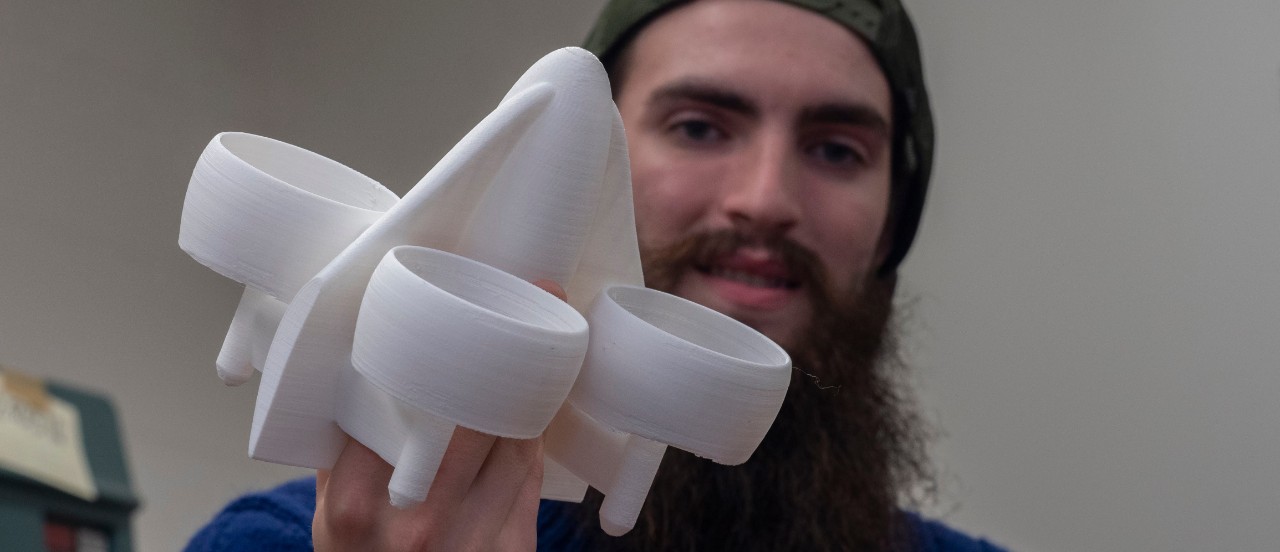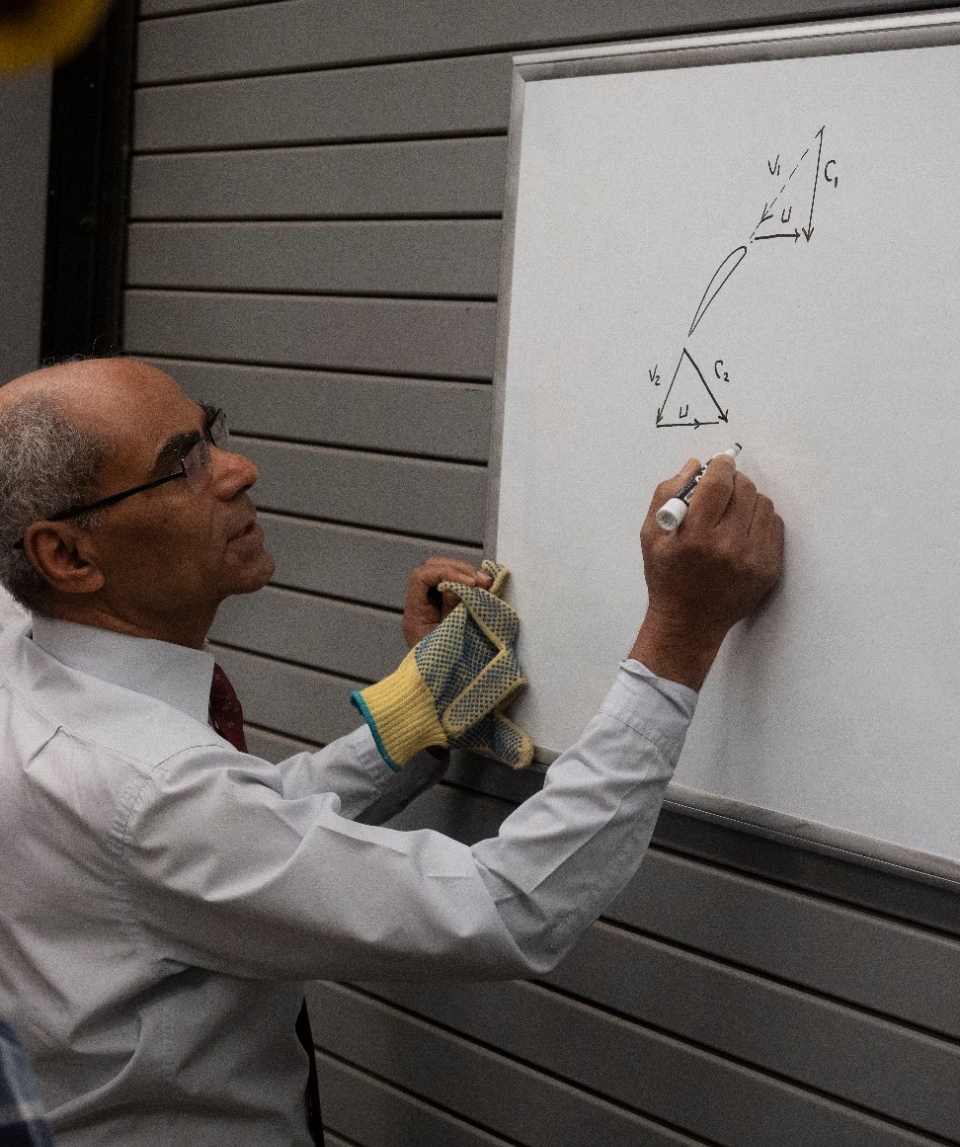
UC students engineer a flying car
The student group FlyUC plans to compete in Boeing's international contest to develop a flying personal vehicle.
The 1982 sci-fi classic “Blade Runner” promised flying cars by 2019, the year the futuristic Ridley Scott movie was set.
Students at the University of Cincinnati are determined to meet that deadline. They started a club, FlyUC, that is participating in an international design competition to build personal vehicles that fly.
The contest, called GoFly, inspires the creation of custom-made flying cars with innovative designs. Contest sponsor Boeing selected its top-10 mock-up designs in the first stage of competition earlier this year. The second stage invites participants, including the design winners, to develop a scale-model that actually flies. The contest wraps up late next year with a “fly-off” of full-size prototypes that can carry an adult passenger or a 200-pound dummy.
The project is another example of UC's commitment to research as part of its strategic direction called Next Lives Here.

UC engineering professor Shaaban Abdallah, advisor to the student group FlyUC, holds up a 3-D printed model of an engine bearing the group's logo. Photo/Jay Yocis/UC Creative Services
Making your morning commute in three dimensions is going to be a reality in our lifetimes, said Shaaban Abdallah, a UC professor of aerospace engineering and advisor to FlyUC.
“Absolutely — 100 percent,” Abdallah said. “They already tested flying taxis last year in Dubai.”
More than a dozen new startups around the world are working on engineering safe, efficient and quiet flying vehicles. Morgan Stanley Research predicts that autonomous flying vehicles could be a trillion-dollar industry by 2040.

UC students used 3-D printed models to visualize their design. The actual scale version will be made with a titanium shell. Pictured are FlyUC members Jacob Gamertsfelder, left, and Heath Palmer. Photo/Jay Yocis/UC Creative Services
Teams in the GoFly competition include universities, private companies and individual inventors. Delft University of Technology in the Netherlands is working on a single-seated helicopter with twin rotors. Trek Aerospace is a team of California engineers who are developing an open-cockpit, 10-rotor aircraft. A team from Calgary, Ontario, is working on a bicopter powered by twin rotors.
FlyUC has already proposed and rejected several designs. One early version launched riders vertically like a rocket and then rotated 90 degrees to fly horizontally at the desired altitude. But the club abandoned this design because of the time constraints of fine-tuning the complicated controls such aerial maneuvering will require.
“We did the simulations, so we knew it would work,” said Jacob Gamertsfelder, a UC aerospace engineering student who is the club’s co-team leader. “But we just didn’t have the time to flesh out that transition.”
Instead, the club is working on a simpler but elegant quadcopter design that might look familiar to anyone who has flown a drone. Along with four ground-facing engines, UC’s flying vehicle has a fifth engine that provides forward thrust so the vehicle can meet the contest’s speed goal of at least 30 knots. UC’s team is aiming for a top speed of about 60 knots or 70 mph.
Propellers were killed off by jet engines. Now they're coming back because of drones.
Shaaban Abdallah, UC engineering professor
Advisor Abdallah encouraged the team to pursue a dual-propeller design in which twin blades spin in opposite directions in each turbine.
“Dual propellers are used in big transport planes that need to carry a lot of weight,” Abdallah said.
“Propellers were killed by jet engines. Now they’re coming back because of drones,” Abdallah said. “Propellers are the most efficient propulsion system at low speed. They are the best way to levitate and, at the same time, they’re very reliable. We have complete confidence in them.”

UC students Heath Palmer, left, and Dival Banerje show off one of the earlier designs for a flying car that would launch vertically like a rocket before rotating to cruise horizontally. Photo/Jay Yocis/UC Creative Services
Gamertsfelder said he is optimistic that flying cars will become more commonplace in years to come.
“I think it’s within the realm of possibility. Certainly, we’ll see more personal flying devices like drones. It will take longer to make them commuter vehicles because of regulations,” he said. “Whether it’s our design or another design, I think people will really like flying.”
Arguably, UC’s students don’t want to be the next Henry Ford. They want to be the next Elon Musk.

UC engineering professor Shaaban Abdallah diagrams an engineering concept on a whiteboard in the FlyUC lab. Photo/Jay Yocis/UC Creative Services
Many of the club’s members participate in another UC club called Hyperloop UC dedicated to developing high-speed tunnel transport. UC competes in Musk’s annual Hyperloop competition at SpaceX headquarters in California. UC’s team will be back in the summer of 2019 to compete in the time trials.
“It’s not just about Hyperloop. It’s about innovative transportation technology,” said Heath Palmer, a UC electrical engineering student and co-team leader of FlyUC.
“The big learning experience for me has been the time management,” Palmer said. “We’re a student organization that is working hard. At the same time, many of us are on co-op or taking classes as well. So we have to manage our time around that.”
Palmer said he appreciates the hands-on experience he gets with projects like Hyperloop UC and FlyUC. But there is also the cool factor of working on a flying car.
“My friends find it amazing where we’re at already,” Palmer said.
Featured image at top: UC engineering student Jacob Gamertsfelder holds up a 3-D model of a flying car. Photo/Jay Yocis/UC Creative Services

Members of FlyUC pose in their engineering lab. Pictured from left: Dival Banerje, Jacob Gamertsfelder, Heath Palmer, UC professor Shaaban Abdallah and Hayden Morgan. Photo/Jay Yocis/UC Creative Services
Next Lives Here
The University of Cincinnati is classified as a Research 1 institution by the Carnegie Commission and is ranked in the National Science Foundation's Top-35 public research universities. UC's graduate students and faculty investigate problems and innovate solutions with real-world impact. Next Lives Here.
Related Stories
Leveling up
May 2, 2025
Meet four College of Allied Health Sciences students who are advancing their education following graduation this May.
UC engineering students recognized for achievement in...
May 1, 2025
Sixteen UC engineering students were honored for outstanding achievement in cooperative education at the close of the 2024-2025 school year.
Everything you need to know about scents and your hair
May 1, 2025
The University of Cincinnati's Kelly Dobos was featured in an NBC News article discussing the science behind hair fragrances and shampoos.
